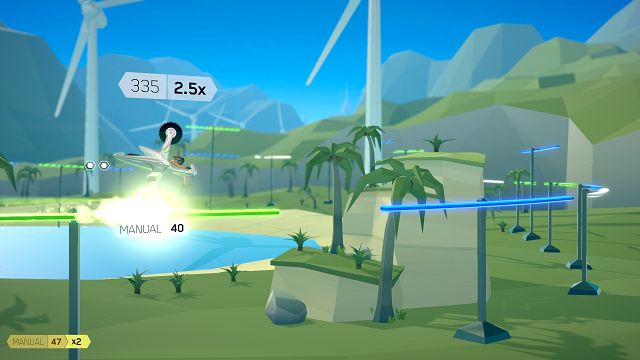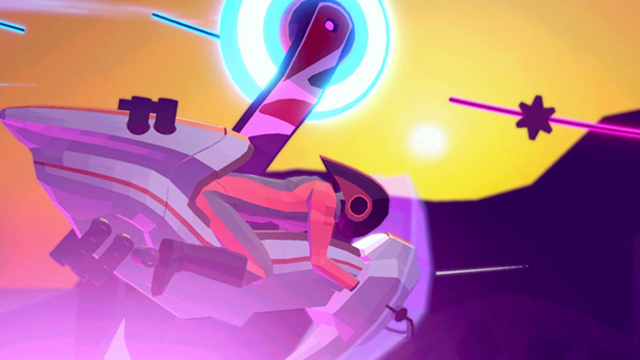There’s something magical in a one-word video game name. Generally, they describe exactly what you get with relative ease and an added cool factor. Doom depicts the dread you feel as you rip and tear through a demonic horde. Battlefield accurately sets you up for a shooter based on large scale military operations. Adding onto the list is FutureGrind, a game about grinding in the future on neon jetbikes. Mashing two words together might be a bit of a cheat, but someone already took Trials.
There’s an entire structure in FutureGrind about evil corporations, conspiracies, and other basics of cyberpunk. It all feels perfunctory. The real meat here is in the hardcore motorbike platforming. In each level, you hop into one of a number of futuristic two-wheeled apparatuses. Tracks are high above the ground and consist of nothing but neon rails. Your wheels can hook onto them from below or balance atop them, but you have to be careful. The color of each wheel corresponds to the color of the rails. Fail to match and you’ll find a pile of flaming wreckage where you hoverbike once stood.
FutureGrind review – Pop Shove-It
It’s a simple setup, but it becomes incredibly complex almost immediately. Each stage autoscrolls, which is necessary since you’ll need to focus entirely on your bike’s positioning. You won’t be finishing runs in one try, but the quick restarts fuel forward momentum and build to an eventual satisfaction. This gameplay feels fine-tuned with speedrunners in mind, and anyone with that competitive mindset will find a lot to like here.
For anyone outside that sphere, FutureGrind becomes a much tougher sell. Genre cohorts like Trials find a more casual audience by presenting an over the top world with plenty of variety. There are a few mechanical tricks here and there, like color shifting zones and bounce pads that can trip you up. However, each stage is visually very similar and ends the same way. Fans of Tony Hawk may appreciate racking up points with sick midair spins, but there’s just not a pull for anyone outside the most masochistic.
If you find yourself stuck, there is an assist mode that turns off the color matching aspect of the gameplay. This does let you progress with some manner of regularity and see all the content. However, this difficulty adjustment swings too far in the other direction. Instead of tough as nails, the game becomes mindless until near the end of the campaign. Each track needs three runs to proceed; one normal and two with bonus objectives. Only the later levels introduce specific enough goals to pose a challenge for easy mode players. At that point, they’ll lack the slick maneuvering necessary to progress.
FutureGrind review – Fakie Superman

Whichever way you choose to play, you’d better enjoy the gameplay. Outside of that, FutureGrind doesn’t really offer much. There are no side modes of note, just a set of levels you can restart over and over. Sure, the content will take a long time to master if you’re playing the right way, but it does feel rather limiting for a game in 2019. There’s no bike customization, no track creator, and no multiplayer; just a set number of levels, a practice area, and a text tutorial.
There are brief text segments between levels desperately trying to tell a story, but they’re instantly forgettable and by the numbers. The only parts of interest occur when players go into “hacked” versions of stages, but they’re over extremely quickly. It’s another missed opportunity to expand on any part of this experience beyond simply mastery.
Composer bignic’s soundtrack is appropriately synthy, keeping the momentum up as you try countless times to land a tricky jump. However, no single track stands out as you go through the levels, especially if you already listen to a lot of ’80s-inspired jams.
FutureGrind review – Benihana

The graphics are colorful but otherwise flat. This may be due to players needing to focus on landing tricks rather than background noise, but it makes everything feel rather generic. Levels always play out in a 2D plane with you zooming towards the right. However, before you get control, you get a flythrough that shows how your bike climbs up, down, and around cityscapes. This should be translated into the game in some way when you actually have control but it just isn’t. This means that the end result has no sense of place.
That’s all there is to FutureGrind. It’s a game that aims low and achieves those goals, but only for a small, niche audience. If your life’s work is mastering this specific brand of platforming, then this is an obvious purchase. Most of the rest of us will find more enjoyment in watching the game streamed during an Awesome Games Done Quick event than actually playing it.
FutureGrind was reviewed on PC via Steam with a code provided by the developer.
-
Solid foundational platforming.
-
Ridiculous complexity in the campaign.
-
Presentation that lacks character.
-
Limited modes and options.
-
Assist mode takes things too far.







